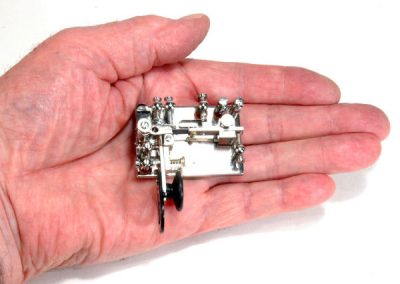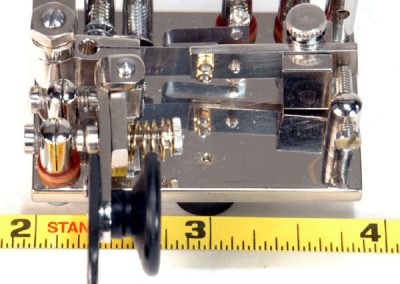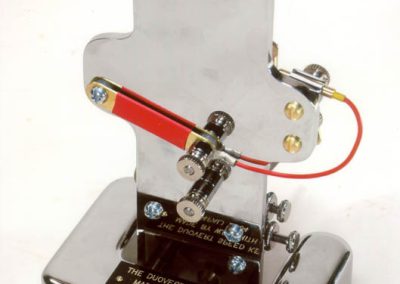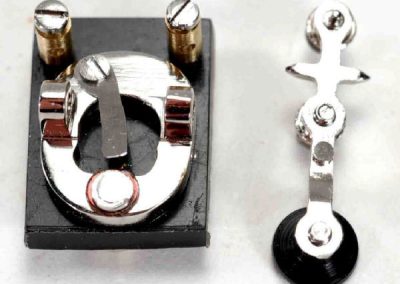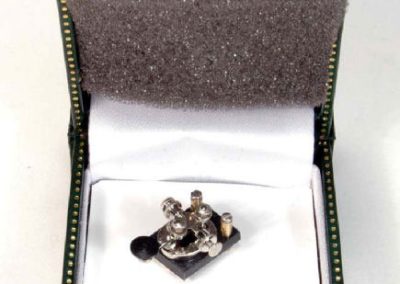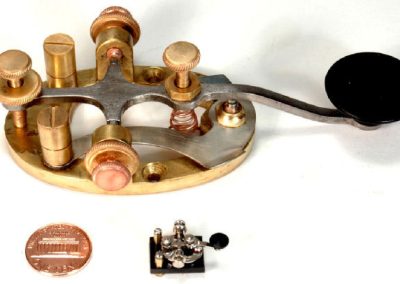Below you can view more photos of some of Mr. Smith’s telegraph speed keys. Click on images to enlarge.
The Minikey Telegraph Speed Key
After seeing a photo of an Ultimate 73 key made by the Los Angeles Transmitter Company, William thought it would be fun to try making one even smaller. The Ultimate 73 key measured about 2-1/2” long. In 2006, William achieved his goal with the completion of The Minikey. While not a copy of the other key, Bill’s Minikey does share certain characteristics in order to function. The Minikey has silver contacts, includes all of the typical adjustments found on a speed key, and functions well on the ham bands. The speed range is about 15 to 35 words per minute.
The Minikey Telegraph Speed Key
The two posts in the upper right hand corner of the key are binding posts, where you would attach a cable for keying the transmitter. The key has three rubber feet, and all metal parts are nickel-plated. To save space, Bill designed the posts so they grip the screws to retain their setting, thus avoiding the need for thumbnuts. The mainspring is held in place by 0–80 pan head screws and nuts. From the ruler in Bill’s photo, you can see he managed to beat the size of the Ultimate 73 key length of 2-1/2″ by a considerable amount. The signet paddle has a letter “S” for Smith.
The Minikey Telegraph Speed Key
Mr. Smith found a ring box in which his Minikey would just fit. This made it easy to carry in a pocket. Naturally, there has been considerable interest in the key among hams; however, Bill was quite pleased by the interest shown from the general public as well.
Duovert Vertical Telegraph Speed Key
A rear view of William’s Duovert telegraph key. The dot contact is a conventional spring, but the dash contact uses a rare earth permanent magnet, which triggers a reed switch. Only weight movements are required for speed changes. The dash weight is first positioned for the desired speed. Then, the dot weight is adjusted to make the correct dot length in correlation with the dash length.
The Nanokey Telegraph Speed Key
In 2006, having just completed his Minikey, Bill decided to build a tiny straight hand key. He had seen a number of small ones in the past, and realized that to be of any interest, his key would need to be even smaller. So, Bill made a base that was about half the diameter of a penny. He then set about making the remainder of the key to fit that base.
The Nanokey Telegraph Speed Key
Rope knurled screws and rope knurled thumbnuts were made for locations where various adjustments had to be made. The little key was assembled and adjusted for a good feel. It was then put on the air, and given a shake-down run to be sure it functioned properly. The Nanokey performed well, and William sent many pictures to friends.
The Nanokey Telegraph Speed Key
Bill carried this tiny key in a ring box, and usually brought a large magnifying glass with it so viewers could admire the details. He also gave out 4 x 6 photo prints to those who had seen it so they could show their friends.
This section is sponsored by:
Makers of precision miniature machine tools and accessories. Sherline tools are made in the USA.
Sherline is proud to confirm that William R. Smith uses Sherline tools and components for some of his small projects.

